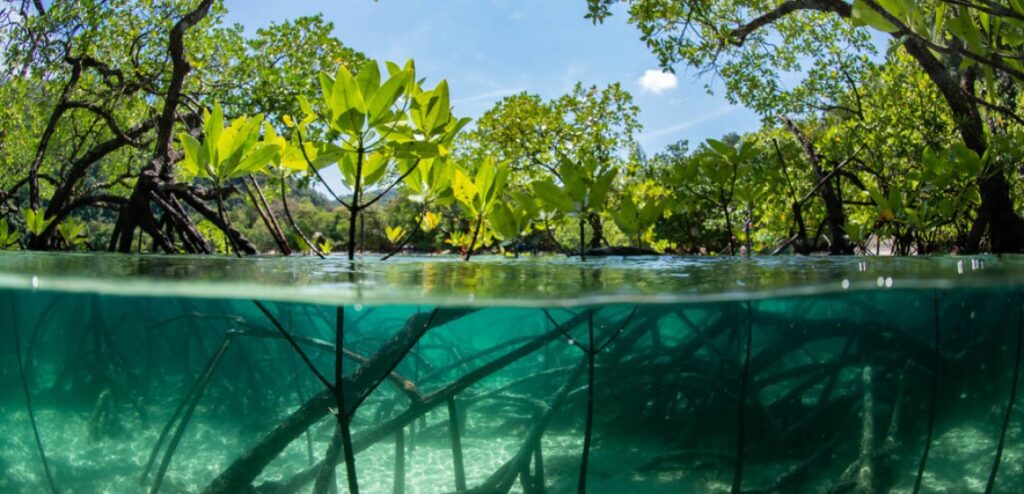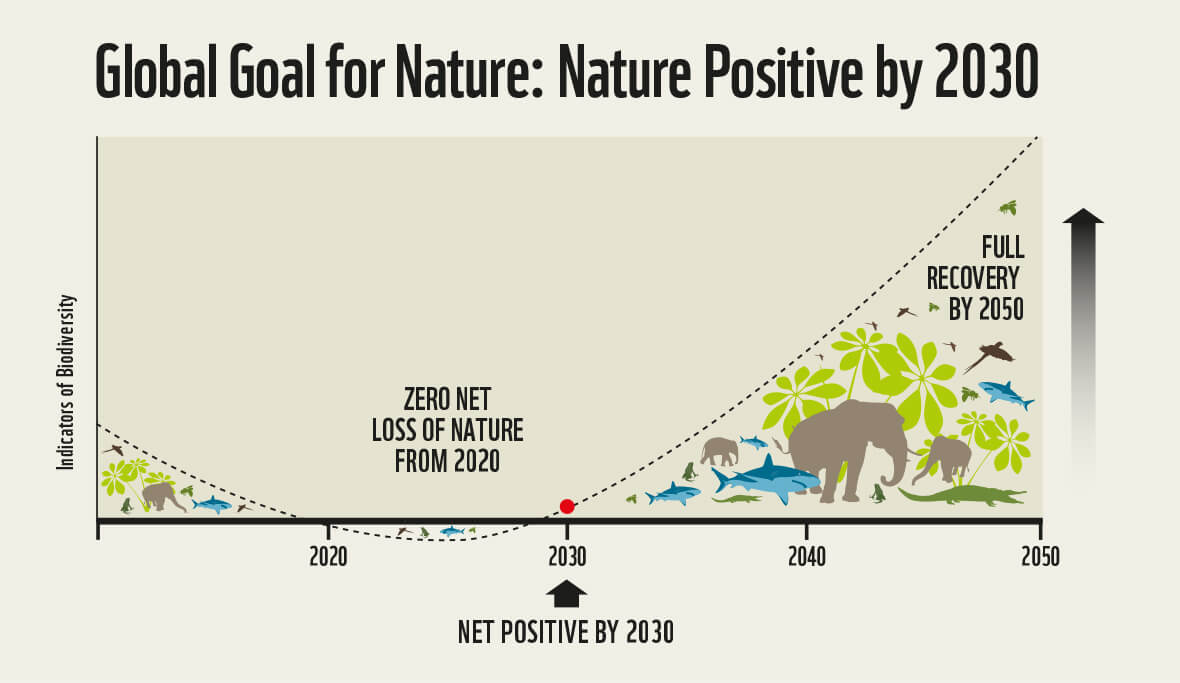Nature-positive by 2030: one big global goal for nature

Biodiversity loss and climate change: two inextricably linked existential threats. Since 2015, we’ve had the universal climate goal of ‘1.5 degrees or under’. Now: introducing a Global Goal for Nature, what ‘nature-positive’ means and how it will be measured.
By Melanie Heath, Director of Science, Policy & Information
The dangerous and worsening decline of biodiversity is well-documented – we know we are destroying natural systems faster than they can replenish themselves. Yet, we completely depend on nature for human health, well-being and prosperity. The recent ‘Dasgupta Review’ on the global economics of biodiversity – commissioned by the UK Treasury – provides further evidence that we have collectively failed the natural world, with demands far outstripping its capacity to supply us with goods and services. The prosperity and health of current and future generations is at risk. With more than half of global gross domestic product (GDP) shown to be moderately or highly dependent on nature, biodiversity loss is among the top five risks to the global economy. COVID is almost ‘small change’ in comparison…
It is clear that our planet is in the red and we have to reset the global compass to protect and conserve the nature we have today, and to halt and reverse nature loss to avoid dangerous consequences for the stability of our planet. The world faces three interconnected crises: biodiversity loss, climate change and human development inequities. But while the Paris Agreement on climate change can be summed up by the actionable goal of carbon-neutrality to keep global heating under 1.5 degrees, no equivalent succinct goal drives ambitions and action for nature, the various dimensions of biodiversity and the agreements in place to protect it.
For years we have been at the forefront working at the nexus of fighting climate change and the loss of biodiversity, knowing how the two crises are inextricably linked. We will not solve either without addressing both together (as the recent joint IPBES and IPCC report stated so clearly). Nature-positive and carbon-neutral go hand in hand.
Through our 1Planet1Right campaign we’re also calling on the United Nations to recognise the universal right to a healthy environment, and to put in place legislation and actions to achieve this, to help ensure that this coming decade is the one in which we transform our relationship with nature, for the sake of all people and the planet.
Image credit: Photos from #TheRaceIsOn campaign to drive action at global conferences in 2021 © Shutterstock

A global goal for nature
At the start of the UN General Assembly and Biodiversity Summit last year, a wide-ranging group of global nature and development NGOs and business organisations called for a clear and overarching Global Goal for Nature. One that can integrate with other global goals to create an “equitable, nature-positive and carbon-neutral future”. The goal can fit into a sentence: nature-positive by 2030 and living in harmony with nature by 2050.
BirdLife, as a co-founder of this group, made the case to set out the scientific and policy justification for the new Global Goal. Drawing on 78 published academic papers, a persuasive 20-page paper has been written – co-authored by a dozen conservation and business organisations – that highlights the unprecedented consensus behind the goal.
As any management consultant will tell you, all goals must be measurable. The paper also points to the approach needed to measure the reverse of nature loss, recommending a focus on abundance, diversity and resilience of species and of ecosystems at a global level. It also advises utilising a mitigation and conservation hierarchy approach that avoids areas that are significant for biodiversity, limits other losses to nature and compensates for unavoidable losses through ecological restoration.
Momentum is building
The momentum behind the ‘nature-positive’ concept has been growing since its inception – both in the NGO and business sectors – and now unites several related initiatives. There is strong interest from some governments too; in September 2020, the heads of over 80 countries signed a Leaders’ Pledge for Nature, committing to reverse biodiversity loss by 2030. Specifically, there is significant political support for conserving and protecting at least 30% of the world’s land and ocean by 2030 (‘30×30’) as evidenced by the 53 countries who support the High Ambition Coalition, which was formally launched at the One Planet Summit for Biodiversity in January 2021. This was again echoed in the recent communique from this June’s G7 meeting, which released a ‘2030 Nature Compact’ stating: “Our world must not only become net zero, but also nature positive.”
The World Economic Forum supports the nature-positive goal, as do coalitions of leading businesses. All of these players understand that a society that is nature-positive by 2030 is imperative to our survival and that – despite fears to the contrary – we can do this with a thriving economy.

- By 2030, we must have more nature through improvements in the health, abundance, diversity and resilience of species, populations and ecosystems. We need all future development and infrastructure to be planned and implemented through a nature-positive lens.
- By 2050, we must be living in harmony with nature. Actions for nature cannot be achieved without addressing both the climate emergency and social justice.
- An equitable, carbon neutral, nature-positive world must be everyone’s goal, starting today.
The race is on
It’s nothing we haven’t said before, but now it’s all united under one global vision: we need to halt the loss of species, safeguard intact natural systems, effectively conserve Key Biodiversity Areas and other important sites for biodiversity, restore human-impacted landscapes, freshwater systems and seascapes, and reduce the consumption and production drivers of biodiversity loss.
It will require action from all parts of society to protect ecosystems, and halt then reverse nature loss through restoration. Tackling the erosion of the natural world requires action not just to protect species and their habitats, but also stopping excessive and destructive business and development practices, addressing both direct and indirect drivers of nature loss.
You may be thinking ‘didn’t the world set global targets in 2010 for the UN Decade on Biodiversity?’ There has been much concern over the world’s failure to meet these Aichi Targets to save nature, and BirdLife has been at the forefront of understanding why. Our latest report Birds & Biodiversity Targets uses our extensive research and expertise to outline the exact shortfalls of the targets. Crucially, it also provides a road map and a message of hope to the world, using bird conservation successes to show that solutions do exist for the problems facing the biosphere, and that nature can recover swiftly when these are enacted.
The UN biodiversity meeting, CBD COP 15, is scheduled to take place in October 2021 in Kunming, China. This year’s goal is to adopt a post-2020 Global Biodiversity Framework, as a crucial stepping-stone towards the 2050 vision of “living in harmony with nature”. As a supporter of the Global Goal for Nature, BirdLife calls on governments to negotiate using an ambitious ‘nature-positive by 2030’ lens.
The addition of a clear nature-positive global goal for nature that can be combined with climate and human development goals would give humanity a guiding ‘North Star/Southern Cross’ for development pathways across the world to bring about an equitable, carbon-neutral future where biodiversity thrives. That sounds nature-positive to me.
Stay up to date
Sign up to receive the latest bird conservation news. You’ll also receive updates about our projects, science and other ways to get involved including fundraising.
Thank you for your support, we are committed to protecting your personal information and privacy. For more information on how we use your data, please see our Privacy Policy. You can unsubscribe from emails at any time by using the link in the footer of any email from us.

